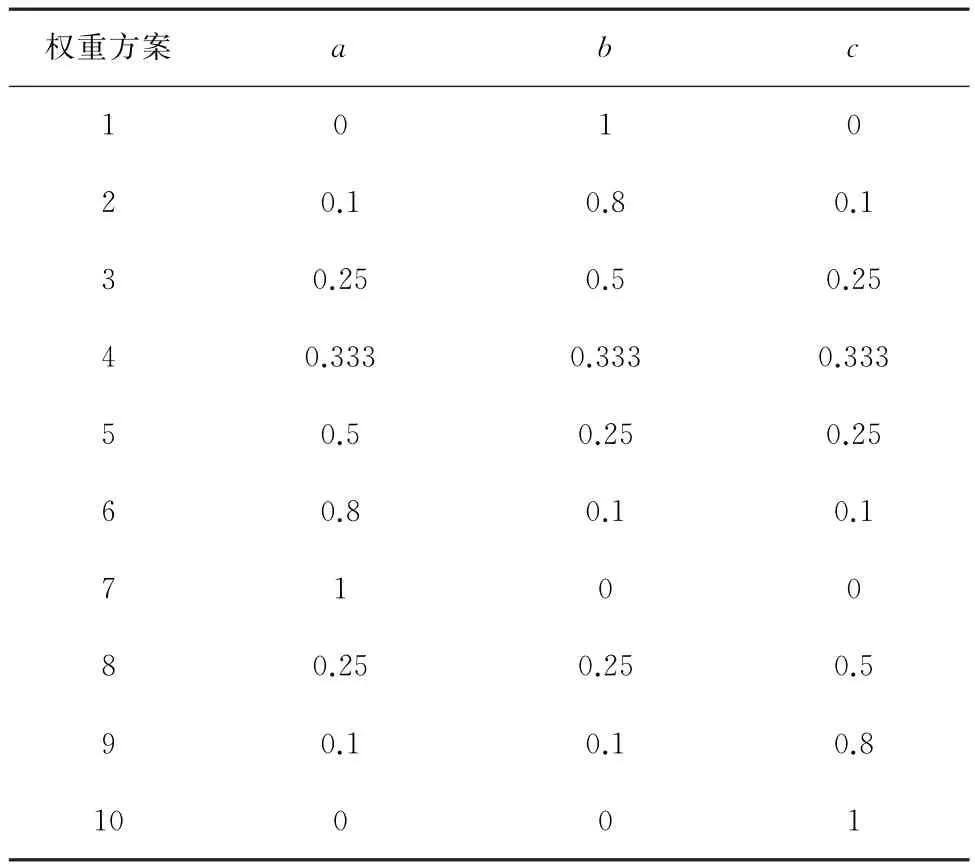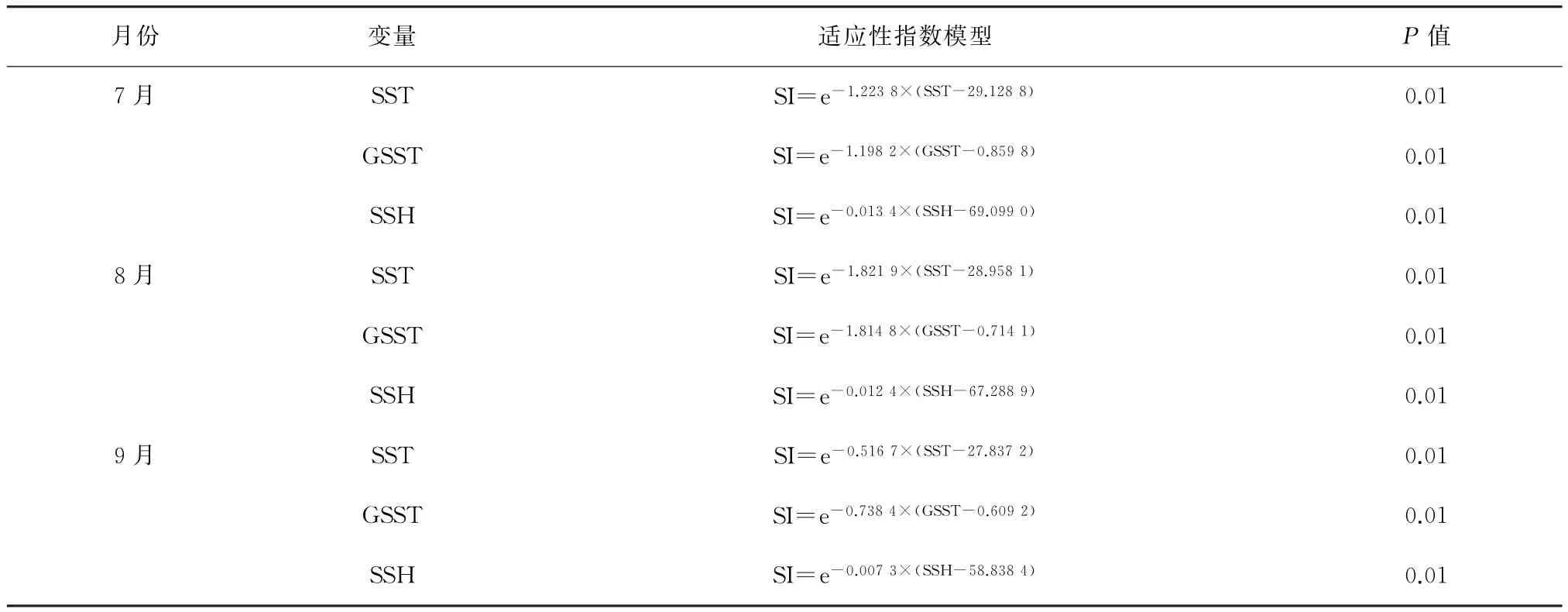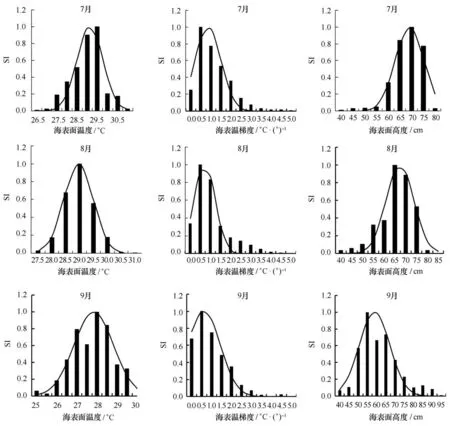不同环境因子权重对东海鲐鱼栖息地模型的影响研究
易炜,郭爱,陈新军,2,3,4,5*
不同环境因子权重对东海鲐鱼栖息地模型的影响研究
易炜1,郭爱1,陈新军1,2,3,4,5*
(1.上海海洋大学 海洋科学学院,上海201306;2.浙江海洋水产研究所,浙江 舟山316021;3.农业部大洋渔业开发重点实验室,上海201306;4.国家远洋渔业工程技术研究中心,上海201306;5.大洋渔业资源可持续开发教育部重点实验室,上海201306)
鲐鱼(Scomber j aponicus)是栖息在西太平洋沿岸的中上层鱼类,了解其栖息地分布及其与海洋环境因子的关系有助于合理开发和管理该资源。本文根据2003—2011年7—9月中国东海鲐鱼的生产数据,采用正态分布函数分别构建海表面温度(sea surface temperature,SST)、海表温梯度(gradient of sea surface temperature,GSST)和海表面高度(sea surface height,SSH)与作业次数的适应性指数(suitability index,SI),基于不同权重的算术平均法(arith metic weighted model,AWM)分别建立栖息地指数(habitat suitability index,HSI)模型,并用2012年7—9月生产数据进行验证。结果显示,7、8、9月各月最佳 HSI模型的SST、STG和SSH的权重分别为0.5、0.25、0.25,0.8、0.1、0.1和0、1.0、0,利用2012年7—9月生产数据与环境数据对各月份最佳权重HSI模型进行验证,在HSI>0.6的海域,7、8、9月各月作业次数比重和产量比重分别为85.87%和92.55%,76.74%和86.69%,51.83%和56.11%。研究表明,不同月份的环境因子对鲐鱼渔场分布的影响程度不同,本研究为更好地预测鲐鱼栖息地奠定了基础。
鲐鱼;栖息地适应性指数;海洋环境因子;基于权重的算术平均法
1 引言
鲐鱼(Scomber j aponicus)属近海中上层鱼类,广泛分布于西太平洋沿海水域,主要为中国、日本、韩国等灯光围网船所利用。中国大陆大型灯光网作业一般从每年3月下旬在东海南部开始捕捞产卵群体,但产量有限。夏季进入渔汛期,以捕捞补充群体和剩余群体为主[1]。渔业资源的空间分布与环境因子密切相关[2-3],已有研究表明,近海鲐鱼渔场分布与海表面温度[4-6]、沿岸水团[5,7]、海表面高度[4]和厄尔尼诺现象[8-9]等环境因子关系密切。栖息地指数(habitat suitability index,HSI)模型最早被用来描述野生动物的栖息地质量[10],是描述动物资源空间分布与环境关系的重要工具,已经广泛地应用于渔场分析与预报[11-16],并取得较好的结果。在以往利用栖息地指数模型对渔业渔场进行预报的研究中,均没有考虑到随着时间变化,不同海洋环境因子对渔场形成与分布的不同影响。因此,本研究假设随时间变化不同海洋环境因子对渔场分布与形成的影响程度不同。为此,本研究基于海表面温度、海表温梯度和海表面高度3个环境因子,建立东海鲐鱼栖息地指数模型,分析不同环境因子随着时间变化对鲐鱼渔场的影响,为合理利用近海鲐鱼资源提供科学依据。
2 材料与方法
2.1 数据来源
2.1.1 渔获数据
本研究的渔获生产统计数据来自中国远洋渔业协会上海海洋大学鱿钓技术组。时间为2003-2012年7-9月,数据包括作业日期、作业位置、渔获量(t)、放网次数,研究区域为东海25°~38°N、122°~128°E,空间分辨率0.1°×0.1°,时间分辨率是月。
2.1.2 环境数据
海表面温度(SST)数据来自美国国家海洋大气局NOAA的Ocean Watch网站http://pifsc-oceanwatch.irc.noaa.gov/erddap/griddap/Ocean Watch_pf5_sst_monthly.ht ml,空间分辨率为0.1°×0.1°,时间分辨率为月。
海表面高度(SSH)数据来自美国国家海洋大气局NOAA的Ocean Watch网站http://pifsc-oceanwatch.irc.noaa.gov/erddap/griddap/Ocean Watch_aviso_ssh_monthly.ht ml,空间分辨率为0.1°×0.1°,时间分辨率为月。
2.2 数据处理
(1)计算海表温梯度(gradient of sea surface temperature,GSST),见图1。

图1 海表温梯度计算示意图Fig.1 The calculation of the gradient of sea surface temperature
SSTi,j点的水平梯度GSSTi.j计算公式如下[17]:
(2)作业次数(即捕捞努力量)是渔船在一定时间一定地点放网的次数,可以作为鱼类偏好或被利用情况的指标[18]。因此,可以利用作业次数与SST、GSST和SSH建立适应性指数(suitability index,SI)模型。假定作业次数最多的海域为鲐鱼资源分布最多的海域,认定其适应性指数SI为1,反之则为0[19]。SI计算公式如下:

式中,SIi为单因子适应性指数;Neti为各月份各捕捞点的作业次数;Netmax为各月中最高作业次数。
(3)利用正态函数分别建立SST、GSST、SSH和SI之间的关系模型。利用DPS软件进行求解,将SST、GSST、SSH和SI两离散变量关系转化为连续随机变量关系。
2.3 HSI建模
利用算术加权法(arith metic weighted model,AWM)建立栖息地指数模型(图2),计算公式如下:
AWM:HSI=a SISST+b SIGSST+c SISSH,(3)式中,a,b,c分别为SST、GSST和SSH的权重,a+b+c=1,取值如表1所示。SISST、SIGSST和SISSH分别为SI与SST、GSST和SSH的适应性指数。

表1 海表温度、海表温梯度和海表面高度的权重取值Tab.1 The weights of sea surface temperature,gradient of sea surface temperature and sea surface height
2.4 模型选择与验证
最佳HSI模型选择,是在不同权重的情况下,当HSI>0.6[14-16]时,综合考虑作业次数的比重和产量的比重进行择优选择。其中作业次数的比重即HSI>0.6时的作业次数占总的作业次数的百分比,产量的比重即HSI>0.6时的产量占总产量的百分比。利用最佳模型,计算2012年7—9月HSI>0.6的海域作业次数比重和产量比重,探讨预测近海鲐鱼中心渔场的可行性。

图2 栖息地指数计算示意图Fig.2 The illustration of esti mating habitat suitability index
3 结果
3.1 7-9月作业次数与环境因子的SI曲线
由图3可知,7月份SST范围为26.5~31℃,最适SST为29.5~30℃,GSST范围为0~5.5℃/(°),最适GSST为0.5~1℃/(°);SSH范围为40~85 c m,最适SSH为70~75 c m;8月份SST范围为27.5~31.5℃,最适SST为29~29.5℃,GSST一般范围为0~5.5℃/(°),最适GSST为0.5~1℃/(°),SSH一般范围为40~90 c m,最适SSH为65~70 c m;9月份SST一般范围为25~30.5℃,最适SST为28~28.5℃,GSST一般范围为0~5.5℃/(°),最适GSST为0.5~1℃/(°),SSH一般范围为40~100 c m,最适SSH为55~60 c m。
利用正态分布函数分别进行SI与环境因子拟合(图3),拟合SI模型见表2,模型拟合通过显著性分析(P<0.01)。

表2 2003-2011年7-9月鲐鱼适应性指数模型Tab.2 The suitability index model of Scomber j aponicus during July to September,2003—2011
3.2 HSI模型分析
利用不同权重的算术加权模型分别计算出HSI,及其HSI>0.6时相应的作业次数比重和产量比重(表3)。首先根据作业次数比重确定各月份比重最大的两个权重方案,再对比这2个权重方案的产量比重,选择产量比重大的权重方案,从而得到最优权重。由表3可知,7月权重a=0.5,b=0.25,c=0.25的AWM为最佳模型;8月权重a=0.8,b=0.1,c=0.1的AWM为最佳模型;9月权重a=0.1,b=0.1,c=0.8的AWM为最佳模型。

图3 2003—2011年7—9月各月份鲐鱼作业次数与环境因子的适应性指数曲线Fig.3 Monthly curve of suitability index for Scomber j aponicus during July to September,2003—2011

表3 2003-2011年7-9月不同权重下HSI大于0.6的海域的作业次数和产量比重Tab.3 The proportion of fishing effort and catches under different weights in the case of HSI greater than 0.6 during July to September,2003—2011

续表3
3.3 HSI模型的验证
根据各月份的最佳栖息地指数模型,分别计算2012年7—9月各种的HSI值,并与实际情况比较。分析发现(表4),7月HSI>0.6的海域,其作业次数和产量比重分别为85.87%和92.56%;8月HSI>0.6的海域,其作业次数和产量比重分别为76.75%和86.70%;9月HSI>0.6的海域,其作业次数和产量比重分别为51.83%和56.11%。

表4 2012年7-9月最佳权重的AWM计算的HSI值与作业次数和产量比重Tab.4 The proportion of fishing effort and catches by AWM with different weights during July to September in 2012
4 讨论
4.1 鲐鱼渔场与环境因子的关系
鲐鱼是一种短寿命的中上层鱼类,容易受到环境和气候变化的影响。SST会对鲐鱼的洄游、生殖和产卵产生直接影响[20-21],从而使鲐鱼集群,形成渔场[22],所以SST是导致鲐鱼资源变动的重要因子[23-24]。研究表明[21,25]每年春季,随着东海水温的回升,鲐鱼从东海南部的越冬场进入浙江近海的产卵场,性腺成熟的鲐鱼就地产卵,产卵结束后游向外海索饵,夏末秋初鲐鱼一般位于东海北部和黄海南部。而春季性腺未成熟的鲐鱼继续北上,春末夏初,进入黄海产卵,产卵结束后在黄海索饵,度过夏季和秋季。秋末,随着黄海水温不断下降,鲐鱼被迫南下洄游,冬季返回越冬场。李纲等[26]研究发现,鲐鱼适宜SST范围随时间变化而变化,7-9月SST范围为26~30℃;苏杭等[27]指出,SST上升对鲐鱼栖息地范围影响是显著的,且不同月份的影响情况明显有差异,这与本研究结果大致相同。
GSST可以用来判断流界,流界附近一般是生物量丰富的区域,更容易形成渔场。其原理是在两种不同水系的交汇区界面水温发生显著变化,出现较大梯度,可以认为是不同生物圈生物分布的一种屏障或境界。随流而来的不同水系的浮游生物和鱼类至此遇到“屏障”,不能逾越均集群于流界附近,从而形成良好的渔场[28],所以GSST与鲐鱼渔场分布有着密切关系。
SSH与海流有关,海流的聚合和辐散分别导致SSH的上升和下降[29],而海流的聚合和辐散可能形成上升流水域,更容易形成优良渔场。其原理是在海洋的上层,浮游植物光合作用较强,海水中的营养盐被消耗,而海洋的深层和海底的沉积物中,有着丰富的营养物质。这些营养物质通过上升流到达表层,在光合作用下产生有机物质,从而形成良好渔场[28]。因此,SSH是影响渔场分布的重要环境因子。因此,本研究利用SST、GSST和SSH作为环境因子,研究其与渔场分布的关系是可行的。
4.2 适应性指数分析
研究结果表明,作业次数与SST、GSST和SSH存在着正态分布关系(P<0.01)。虽然CPUE可作为表征资源密度的指标[30],但商业性渔业的CPUE作为资源丰度的指标并不一定可靠。主要是因为资源丰度较高的海域,渔民更倾向于在此海域从事捕捞,导致渔船数量较多,作业次数较多,由于渔船数量过多而产生相互之间的负外部性,使得捕捞产量下降,导致单位捕捞努力量渔获量(CPUE)反而不高。因此,本文利用作业次数与环境因子建立适应性指数模型[31]。
4.3 基于不同权重的栖息地指数模型分析
HSI模型的数据输入取决于基于不同环境因子的SI模型的结果[32]。本研究在建立HSI模型时,考虑到随着时间变化不同环境因子影响鲐鱼渔场分布的差异,对不同月份的环境因子赋予权重进行探讨。研究结果表明,在HSI模型中考虑权重后,其预报精度得到提高,这在胡贯宇等[33]对阿根廷柔滑鱼栖息地研究和蒋瑞等[34]对秋冬季智利竹筴鱼栖息地研究中也有类似情况。因此,本研究认为,不同月份的环境因子对鲐鱼渔场分布的影响程度不同。7、8月份影响鲐鱼渔场分布的环境因子主要是SST,而9月份影响鲐鱼渔场分布的环境因子主要是GSST。之所以导致这样变化的原因可能与鲐鱼在生长过程不同时期对不同环境因子的适应能力有关。值得注意的是造成9月份HSI为0~0.2范围内的作业次数和产量比高可能的原因主要为:(1)在渔场中存在两个群系,日本鲐和澳洲鲐,它们对环境的响应能力存在差异;(2)同一群系鲐鱼的性成熟时间与产卵场地也有差异,性成熟的鲐鱼在东海渔场产卵,未成熟的则继续北上进入黄海。
4.4 鲐鱼栖息地适应性模型的完善
在实际生产中,渔场形成与分布及其受环境因子影响的过程非常复杂。因此,在今后研究中,还需要对鲐鱼生活史和群系分布进行更深入的研究,建立HSI模型时考虑更多环境因子如叶绿素浓度、海表面盐度等,加以综合分析与研究;对于基于权重的HSI模型,可以尝试使用计算机进行模拟以选择最佳权重,使得模型更加准确,以期建立更加完善、综合的栖息地指数模型。
[1] 李纲,陈新军.东海鲐鱼资源和渔场时空分布特征的研究[J].中国海洋大学学报,2007,37(6):921-926.Li Gang,Chen Xinjun.Tempo-spatial characteristic analysis of the mackerel resource and its fishing ground in the East China Sea[J].Periodical of Ocean University of China,2007,37(6):921-926.
[2] Anderson T J,Sy ms C,Roberts D A,et al.Multi-scalefish-habitat associations and the use of habitat surrogates to predict the organisation and abundance of deep-water fish assemblages[J].Journal of Experi mental Marine Biology and Ecology,2009,379(1/2):34-42.
[3] Freeman S M,Rogers SI.A new analytical approach to the characterisation of macro-epibenthic habitats:linking species to the environ ment[J].Estuarine,Coastal and Shelf Science,2003,56(3/4):749-764.
[4] 李纲,陈新军.夏季东海渔场鲐鱼产量与海洋环境因子的关系[J].海洋学研究,2009,27(1):1-8.Li Gang,Chen Xinjun.Study on t he relationship bet ween catch of mackerel and environ mental factorsin the East China Seain su mmer[J].Journal of Marine Sciences,2009,27(1):1-8.
[5] 张晶,韩仕鑫.黄、东海鲐鲹鱼渔场环境分析[J].海洋渔业,2004,26(4):321-325.Zhang Jing,Han Shixin.Analysis on the central fishing grounds environ ment of co mmon Japanese mackerel and round scad in the East China Sea[J].Marine Fisheries,2004,26(4):321-325.
[6] 李纲,郑晓琼,朱国平,等.基于水温因子的东、黄海鲐鱼剩余产量模型建立[J].上海海洋大学学报,2011,20(1):108-113.Li Gang,Zheng Xiaoqiong,Zhu Guoping,et al.Establish ment of surplus production model for chub mackerel(Scomber j aponicus)in the East China Sea and Yellow Sea based on the sea surface temperature[J].Journal of Shanghai Ocean University,2011,20(1):108-113.
[7] 杨红,章守宇,戴小杰,等.夏季东海水团变动特征及对鲐鲹渔场的影响[J].水产学报,2001,25(3):209-214.Yang Hong,Zhang Shouyu,Dai Xiaojie,et al.Characteristics of water masses and its influence on mackerel scad fishery in the East China Sea in the su mmer[J].Journal of Fisheries of China,2001,25(3):209-214.
[8] 洪华生,何发祥,杨圣云.厄尔尼诺现象和浙江近海鲐鲹鱼渔获量变化关系——长江口ENSO渔场学问题之二[J].海洋湖沼通报,1997(4):8-16.Hong Huasheng,He Faxiang,Yang Shengyun.El Niño pheno menon and variation of catch of Scomber j aponicus and Decapterus maruadsi in offshore waters of Zhejiang Province[J].Transactions of Oceanology and Li mnology,1997(4):8-16.
[9] Sun C H,Chiang F S,Tsoa E,et al.The effects of El Niño on the mackerel purse-seinefishery harvestsin Taiwan:an analysisintegrating t he barometric readings and sea surface temperature[J].Ecological Economics,2006,56(2):268-279.
[10] Duel H,Specken B P M,Denneman W,et al.The habitat evaluation procedure as a tool for ecological rehab:Ilitation of wetlandsin The Netherlands[J].Water Science and Technology,1995,31(8):387-391.
[11] Chen Xinjun,Li Gang,Feng Bo,et al.Habitat suitability index of chub mackerel(Scomber j aponicus)fro m July to September in the East China Sea[J].Journal of Oceanography,2009,65(1):93-102.
[12] Chen Xinjun,Tian Siquan,Chen Yong,et al.A modeling approach to identify opti mal habitat and suitable fishing grounds for neon flying squid(Ommastrephes bartra mii)in the Northwest Pacific Ocean[J].Fishery Bulletin,2010,108(1):1-14.
[13] 陈新军,冯波,许柳雄.印度洋大眼金枪鱼栖息地指数研究及其比较[J].中国水产科学,2008,15(2):269-278.Chen Xinjun,Feng Bo,Xu Liuxiong.A comparative study on habitat suitability index of bigeye tuna,Thunnus obesus in the Indian Ocean[J].Journal of Fishery Sciences of China,2008,15(2):269-278.
[14] 方宇,邹晓荣,张敏,等.东南太平洋智利竹筴鱼栖息地指数的比较研究[J].海洋渔业,2010,32(2):178-185.Fang Yu,Zou Xiaorong,Zhang Min,et al.A comparative study on habitat suitability index of Chilean Jack Mackerel in southeast Pacific Ocean[J].Marine Fisheries,2010,32(2):178-185.
[15] 陈新军,陆化杰,刘必林,等.利用栖息地指数预测西南大西洋阿根廷滑柔鱼渔场[J].上海海洋大学学报,2012,21(3):431-438.Chen Xinjun,Lu Huajie,Liu Bilin,et al.Forecasting fishing ground of Illex ar gentinus by using habitat suitability model in the southwest Atlantic[J].Jour nal of Shanghai Ocean University,2012,21(3):431-438.
[16] 高峰,陈新军,范江涛,等.西南大西洋阿根廷滑柔鱼中心渔场预报的实现及验证[J].上海海洋大学学报,2011,20(5):754-758.Gao Feng,Chen Xinjun,Fan Jiangtao,et al.Implementation and verification of intelligent fishing ground forecasting of Illex ar gentinus in the Southwest Atlantic[J].Journal of Shanghai Ocean University,2011,20(5):754-758.
[17] 陈新军,刘必林,田思泉,等.利用基于表温因子的栖息地模型预测西北太平洋柔鱼(Ommastrephes bartra mii)渔场[J].海洋与湖沼,2009,40(6):707-713.Chen Xinjun,Liu Bilin,Tian Siquan,et al.Forecasting the fishing ground of Ommastrephes bartr a mii with SST-based habitat suitability modelling in northwestern pacific[J].Oceanologia et Li mnologia Sinica,2009,40(6):707-713.
[18] Andrade H A,Garcia C A E.Skipjack tuna fishery in relation to sea surface temperature off the southern Brazilian coast[J].Fisheries Oceanography,1999,8(4):245-254.
[19] Mohri M,Nishida T.Seasonal changes in bigeye tuna fishing areas in relation to the oceanographic parameters in t he Indian Ocean[J].Journal of National Fisheries University,1999,47(2):43-54.
[20] 张孝威.鲐鱼[M].北京:农业出版社,1983.Zhang Xiaowei.Mackerel[M].Beijing:China Agriculture Press,1983.
[21] 李纲.东、黄海鲐鱼资源评估及其管理策略风险分析[D].上海:上海海洋大学,2008.Li Gang.Stock assessment and risk analysis of alternative management strategies for chub mackerel(Scomber j aponicus)in the East China Sea and the Yellow Sea[D].Shanghai:Shanghai Ocean University,2008.
[22] 王云龙,沈新强,李纯厚,等.中国大陆架及邻近海域浮游生物[M].上海:上海科学技术出版社,2005.Wang Yunlong,Shen Xinqiang,Li Chunhou,et al.Plankton of the China Continental Shelf and Adjacent Waters[M].Shanghai:Shanghai Science and Technology Press,2005.
[23] Hiyama Y,Yoda M,Ohshi mo S.Stock size fluctuationsin chub mackerel(Scomber j aponicus)in the East China Sea and the Japan/East Sea[J].Fisheries Oceanography,2002,11(6):347-353.
[24] Yatsu A,Watanabe T,Ishida M,et al.Environ mental effects on recruit ment and productivity of Japanese sardine Sar dinops melanostictus and chub mackerel Scomber j aponicus with recommendations for management[J].Fisheries Oceanography,2005,14(5):263-278.
[25] 唐启升.中国专属经济区海洋生物资源与栖息环境[M].北京:科学出版社,2006 Tang Qisheng.Marine Biological Resources and Habitat Environ ment in China’s Exclusive Econo mic Zone[M].Beijing:Science Press,2006.
[26] 李纲,陈新军,田思泉.我国东、黄海鲐鱼灯光围网渔业CPUE标准化研究[J].水产学报,2009,33(6):1050-1059.Li Gang,Chen Xinjun,Tian Siquan.CPUEstandardization of chub mackerel(Scomber Japonicus)for Chineselargelighting-purse seinefishery in the East China Sea and Yellow Sea[J].Journal of Fisheries of China,2009,33(6):1050-1059.
[27] 苏杭,陈新军,汪金涛.海表水温变动对东、黄海鲐鱼栖息地分布的影响[J].海洋学报,2015,37(6):88-96.Su Hang,Chen Xinjun,Wang Jintao.Influence of sea surface temperature changes on Scomber j aponicas habitat in the Yellow Sea and East China Sea[J].Haiyang Xuebao,2015,37(6):88-96.
[28] 陈新军.渔业资源与渔场学[M].北京:海洋出版社,2004:149-157.Chen Xinjun.Fisheries Resources and Risheries Rtudies[M].Beijing:China Ocean Press,2004:149-157.
[29] Polito P S,Sato O T,Liu W T.Characterization and validation of the heat storage variability from TOPEX/Poseidon at four oceanographic sites[J].Jour nal of Geophysical Research,2000,105(C7):16911-16921.
[30] Bertrand A,Josse E,Bach P,et al.Hydrological and trophic characteristics of tuna habitat:consequences on tuna distribution and longline catch ability[J].Canadian Journal of Fisheries and Aquatic Sciences,2002,59(6):1002-1013.
[31] Stoner A W,Spencer M L,Ryer C H.Flatfish-habitat associationsin Alaska nursery grounds:use of continuous video records for multi-scale spatial analysis[J].Journal of Sea Research,2007,57(2/3):137-150.
[32] Tian Siquan,Chen Xinjun,Chen Yong,et al.Evaluating habitat suitability indices derived from CPUE and fishing effort data for Ommatrephes bratr a mii in t he nort hwestern Pacific Ocean[J].Fisheries Research,2009,95(2/3):181-188.
[33] 胡贯宇,陈新军,汪金涛.基于不同权重的栖息地指数模型预报阿根廷滑柔鱼中心渔场[J].海洋学报,2015,37(8):88-95.Hu Guanyu,Chen Xinjun,Wang Jintao.Forecasting fishing ground of Illex ar gentinus based on different weight habitat suitability index in the southwestern Atlantic[J].Haiyang Xuebao,2015,37(8):88-95.
[34] 蒋瑞,陈新军,雷林,等.秋冬季智利竹筴鱼栖息地指数模型比较[J].水产学报,2017,41(2):240-249.Jiang Rui,Chen Xinjun,Lei Lin,et al.A comparative study on habitat suitability index of Tr achurus mur phyi during autu mn and winter[J].Journal of Fisheries of China,2017,41(2):240-249.
Astudy on influence of different environmental factors weights on the habitat model for Scomber j aponicus
Yi Wei1,Guo Ai1,Chen Xinjun1,2,3,4,5
(1.College of Marine Sciences,Shanghai Ocean University,Shanghai 201306,China;2.Marine Fisheries Research of Zhejiang,Zhoushang 316021,China;3.Key Laboratory of Oceanic Fisheries Exploration,Ministry of Agriculture,Shanghai 201306,China;4.National Engineering Research Center for Oceanic Fisheries,Shanghai 201306,China;5.Key Laborator y of Sustainable Exploitation of Oceanic Fisheries Resources,Ministry of Education,Shanghai 201306,China)
Scomber j aponicus is a pelagic fish that inhabits the western Pacific Ocean.Understanding the distribution of its fishery and the relationship with marine environ mental factors could help us to make reasonable use of the fishery stock.In this study,based on the production data of S.j aponicus from July to September,2003-2011,as well as sea surface temperature(SST),gradient of sea surface temperature(GSST),sea surface height(SSH)and fishing effort to establish the suitability index(SI)through using nor mal distribution function.This study used different weights to establish habitat suitability index(HSI)through using arith metic weighted model(AWM),and using production data of July to September in 2012 to verify.The results show that the monthly suitable weights of SST,STGand SSH from July to September is 0.5,0.25,0.25;0.8,0.1,0.1,and 0,1.0,0.According to the data during July to September in 2012,we found that the main fishing ground is distributed in the waters with HSI greater than 0.6,and the monthly proportion of fishing effort and catch fro m July to September was 85.87%and 92.55%,76.74%and 86.69%,51.83%and 56.11%.It is concluded that in different months different environ mental factors have different effects on the distribution of S.j aponicus fishery.This study laid the foundation for better predicting the fishing grounds of S.j aponicus.
Scomber j aponicus;habitat suitability index;oceanic environ mental factor;arith metic weighted mean model
S932
A
0253-4193(2017)12-0090-08
易炜,郭爱,陈新军.不同环境因子权重对东海鲐鱼栖息地模型的影响研究[J].海洋学报,2017,39(12):90—97,
10.3969/j.issn.0253-4193.2017.12.009
Yi Wei,Guo Ai,Chen Xinjun.Astudy oninfluence of different environmental factors weights on the habitat model for Scomber j aponicus[J].Haiyang Xuebao,2017,39(12):90—97,doi:10.3969/j.issn.0253-4193.2017.12.009
2017-04-19;
2017-07-06。
海洋局公益性行业专项(20155014);上海市科技创新计划(15DZ1202200)。
易炜(1993—),男,浙江省温州市人,主要从事渔业资源研究。
*通信作者:陈新军。E-mail:xjchen@shou.edu.cn

